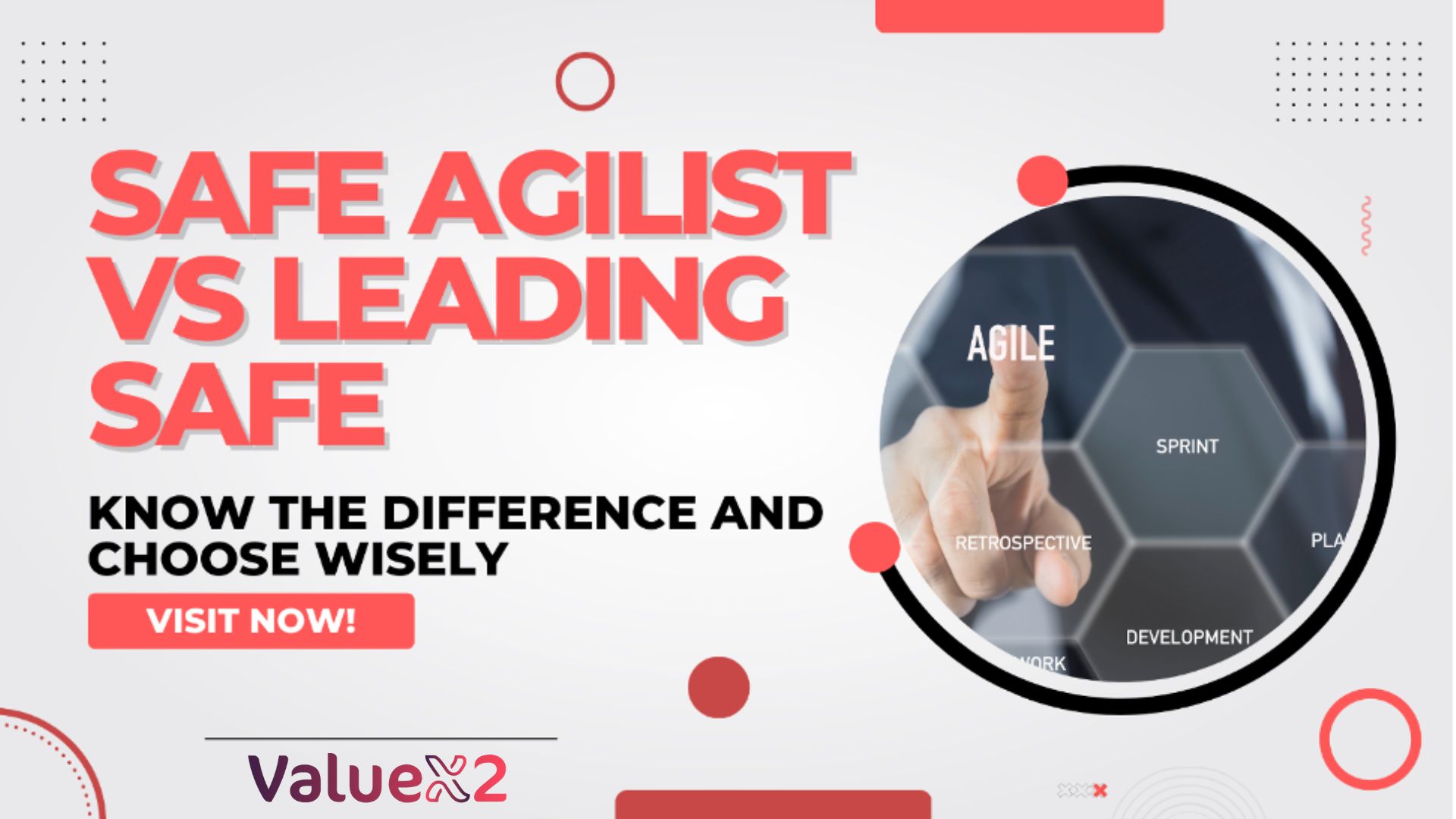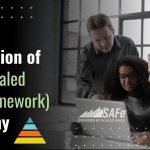Find out the differences between SAFe Agilist and Leading SAFe Agilist. Know the roles & responsibilities, steps to certification and benefits of SAFe Agilist certification.

There has been some confusion and debate over the differences between SAFe Agilist certification and Leading SAFe certification across the internet. In this article, we answer this question, highlighting the differences (if any) and similarities between Leading SAFe course and how it helps one become a SAFe Agilist.
Are you ready to find out? Read on!
What is Leading SAFe Certification Training?
As a business transformation agent, you may come across two terms very often- Scaled Agile Framework (SAFe) Agilist and Leading SAFe. Though both of these terms are related to SAFe (Scaled Agile Framework), the former is the name of the SAFe certification that one obtains by doing the latter i.e. the Leading SAFe training.
In this blog, we will help you understand the difference between the two so that you can make an informed decision while choosing a SAFe certification path for yourself and your organization.
SAFe Agilist is a title given by the Scaled Agile framework to an individual who has completed a training course and exam on SAFe principles and practices. By taking this SAFe certification path anyone new to the Scaled Agile Framework, will get the guidance, tools, and understanding of how to start the SAFe Business Agility Transformation within their organization.
The role of a certified SAFe Agilist is to:
- Align the company around clear objectives,
- Improve the flow of value from strategy to delivery,
- Developing a lean-agile mindset and culture,
- Establish team and technical agility, and
- Build customer-centric solutions.
Leading SAFe is a certification program offered by Scaled Agile that trains individuals on how to lead a successful SAFe transformation.
So, if you want to learn more about how to lead an agile transformation at an enterprise scale, Leading SAFe is the right program for you.
Upon completion of the Leading SAFe class two-day online course or in-person live instructor-led training and passing the certification exam on the community platform, the participant will obtain the “SAFe Agilist” certificate.
Is SAFe Agilist the same as Leading SAFe?
Should I attend the Leading SAFe training or the SAFe Agilist Training? What is the SAFe Agilist Certification? Is Leading SAFe 5.0 certification now replaced by Leading SAFe 6.0 certification?
Lets deep dive and demystify these questions for you!
When it comes to SAFe Agilist vs Leading SAFe, the key difference is that one becomes a Certified SAFe® Agilist (SA) with Leading SAFe® 6.0 Training.
The participant will then be known as Certified SAFe Agilist. The Leading SAFe certification training will help you undertstand how to thrive in the Digital Age with Business Agility. Although there are other globally recognized certification courses like those provided by ICAgile to learn Business Agility Foundations (ICP-BAF). The key difference between ICAgile vs SAFe is that SAFe certification helps implement the “Scaled Agile Framework” to achieve Business Agility whereas, the ICP-BAF is more framework agnostic.
What is covered in Leading SAFe Certification?
After attending the two-day Leading SAFe course you will learn the below that will assist you to perform the role as a SAFe Agilist 6.0 (previously known as leading safe 5.0 certification):
- Interpret the basic constructs of SAFe and the steps of the Implementation Roadmap
- Apply the values and principles of a Lean-Agile Mindset
- Apply SAFe’s Lean and Agile principles to the roles and practices of SAFe
- Create high-performing teams by establishing mission and purpose
- Use transformational leadership to drive change, develop people, and encourage innovation
- Support PI Planning and the events
- Drive continuous value delivery through the Continuous Delivery Pipeline
- Establish alignment and execution of Strategic Themes with Lean Portfolio Management
- Coordinate multiple Agile Release Trains and suppliers with a Solution Train
Steps for Qualification & Certification Requirements for Each Level
As organizations look to adopt lean and agile practices on a larger scale, the Scaled Agile Framework (SAFe) has emerged as a popular option. SAFe is a comprehensive framework for implementing lean and agile software and product development at scale and provides guidance on everything from team structure to enterprise-level planning.
To become a certified SAFe Agilist, candidates must first complete an online course that covers the below topics. After successfully completing the course, candidates must then pass an online exam consisting of multiple-choice and scenario-based questions.
What are the Topics covered in the Leading SAFe 6.0 Certification Training?
- Introducing the Scaled Agile Framework
- Embracing a Lean-Agile Mindset
- Understanding SAFe Principles
- Creating high-performing teams and programs
- Experiencing Planning Interval (PI) Planning
- Exploring, Executing, and Releasing Value
- Leading the Lean-Agile Enterprise
- Empowering a Lean Portfolio
- Building Large Solutions
What are the Roles & Responsibilities of a SAFe Agilist as a Leading SAFe Practitioner?
As a SAFe Agilist, you will be responsible for guiding and coaching teams in the adoption of the SAFe framework. You will also be responsible for facilitating design thinking and decision-making around value creation, business objectives, and strategy execution. As a Leading SAFe Practitioner, you will be responsible for driving the transformation to a Lean-Agile enterprise. This includes working with senior leaders to develop and implement the strategy, providing thought leadership and guidance on Lean-Agile methods and practices, and coaching executives, managers, and Scrum Masters.
Ideally, one must become a SAFe Agilist and then depending upon their role within the Scaled Agile Framework (SAFe) take the next SAFe certification training.
- Scrum Master – SAFe Scrum Master Certification (SSM) Training
- Product Owner/Product Manager – SAFe Product Owner/Product Manager (POPM) Certification Training
- Agile Team Member – SAFe for Teams (SP) Certification Training
Benefits of SAFe Agilist Certification
Now that the SAFe Agilist certification is becoming more and more popular, it’s important to understand the benefits of acquiring this credential. If you have these questions in your mind:
Which is SAFe certification is the best to start with?
Is the Leading SAFe certification worth it?
What results will I get a as a SAFe Agilist?
Is Leading SAFe a good certification?
Then, the below benefits should help convince you to do the SAFe Agilist certification.
Here are five major reasons why a SAFe Agilist certification is important for practitioners:
- Increased efficiency – A SAFe Agilist understands how to optimize their workflows within the framework of SAFe, leading to increased efficiency.
- Adaptability – A SAFe Agilist is able to quickly adapt their processes to meet the specific needs of their organization.
- Consistent execution – By following an approved process template, a SAFe Agilist ensures consistent execution across their organization.
- Continuous improvement – Incorporating best practices into your processes allows you to continuously improve your results.
- Enhanced reputation – A SAFe Agilist certification can help you build a strong reputation in your industry, making you more attractive to potential clients and partners.
Additional Benefits of Leading SAFe Certification
With the increasing globalization of the world and the growing impact of cyber-attacks on organizations, having a strong understanding of effective cybersecurity practices is crucial for leaders in both society and the workplace. One way to achieve this is through certification, such as Leading SAFe.
Credibility and Recognition
Leading SAFe certification provides an unparalleled level of credibility and recognition in the industry. Employers value professionals who are SAFe-certified as they have been educated on best practices in cyber security and have a proven track record of delivering quality solutions.
Career Growth Opportunities
Holding a Leading SAFe certification can provide many career growth opportunities. Certified professionals can work with companies requiring high levels of cybersecurity compliance and can become experts in their field. They can also share their knowledge with others through speaking engagements or writing articles.
Continuous Improvement
Leading SAFe certification is a commitment to continuous improvement in the field of cyber security. Those who hold this certification are dedicated to staying up-to-date with the latest practices and technologies to ensure the highest levels of safety and security for their organizations.
Comparison – What and Why Should You Choose?
What is SAFe?
SAFe is built utilising Extreme Programming methodology, popularized by Kent Beck and Erich Gamma in the 1990s. It emphasizes “effectiveness over stability” and strives to deliver concrete value to stakeholders.
It blends aspects of Lean Management with process improvement best practices from iteration-based software development. It takes a “systems thinking” approach that Mississauga Mayor Bonnie Crombie has said can help cities meet their sustainability goals more efficiently and effectively.
Which one should you choose?
1) Goal orientation: Leading SAFe is oriented around achieving systemic change. as a SAFe Agilist you will be focused on optimizing value for stakeholders.
2) Technical methodology: SAFe Agilist favors pragmatic methodologies geared towards delivering concrete value. Leading SAFe will train you to adopt a more systematic approach that considers all aspects of the system.
3) Stakeholder engagement: Leading SAFe places greater emphasis on engaging all stakeholders in order to create buy-in and alignment around systems goals. SAFe Agilist focuses on building highly engaging teams and Teams of Teams that are solely responsible for the delivery of value to clients while achieving business outcomes.
4) Organizational structure: Leading SAFe relies on self-organizing teams composed of geographically dispersed individuals with diverse backgrounds and skills.
Conclusion
Hopefully, we have cleared the confusion and you know the difference between SAFe Agilist and Leading SAFe can help you make a well-informed decision about which certification is right for your work. If you’re interested in building strong teams, developing high-quality products, or streamlining business processes, then becoming a certified SAFe Agilist will be an ideal fit for your profession. By opting first for your SAFe Agilist certifications with Leading SAFe certification, you will gain basic knowledge of core principles and benefits from scaling agile practices leveraging the Scaled Agile Framework, which are more valuable to you than coaching or executing end-to-end transformation or change initiatives within an organization. These work best for your career goals and objectives.
Also Read: Learn about Leading SAFe®, its benefits, and the SAFe® certification process

Bhavna is an Agile Coach and Consultant with over a decade of experience in advisory, corporate finance, IT assurance, and operations at Big 4 and within the industry in the UK and India. She has recently been the CEO of a start-up where she implemented agile practices within HR, Marketing, and Product teams.
She is also a SAFe® Practice Consultant (SPC) and authorized instructor for ICAgile Agility in HR (ICP-AHR), Agility in Marketing (ICP-MKG), and Business Agility Foundations (ICP – BAF) training courses. She provides training for agile transformation to corporate, public, and private batches, as well as consulting for enterprise agile transformation.






